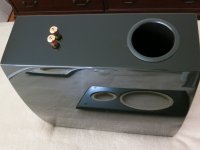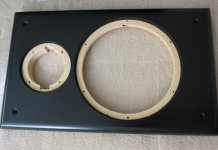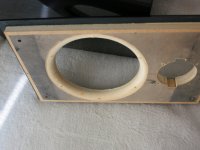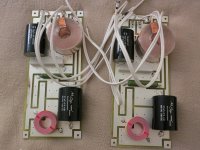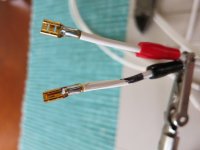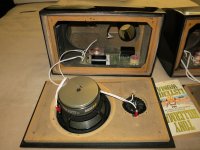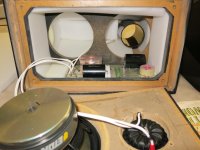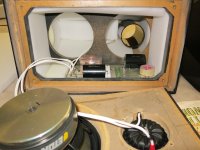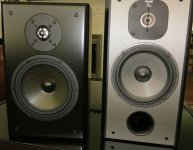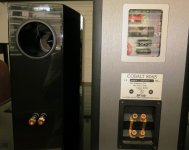Eton S-7 Kit
It was time for some new speakers to accompany a change from a single-ended tube amp to solid state. Single-ended is great, but moving to a new house changed the listening situation.
I am a big fan of Troels Gravesen and his website, which is an absolute delight. I have been tempted to build many of his designs over the past several years, and he certainly has covered the bases with his SEAS and Scan Speak designs. If I had room I would build his latest open-baffle design (OB11), but my new house and rooms are small. Also, in America ordering from Jantzen introduces the uncertainties of the weak dollar plus overseas shipping and customs fees. Tony Gee and John Krutke have provided huge amounts of information to the DIY speaker building community and also deserve mention here.
After a lengthy mental shopping process I ended up going to Madisound and buying the Eton S-7 kit. The higher efficiency appealed to me: 90dB @ 2.83v is very different than 84dB, and both SEAS and Scan Speak seem to be in the 84dB camp these days. Also, I was unable to find much information about Eton on the web, in contrast to the two S-brands, so it seemed like a bit more of an interesting adventure.
The Symphony series appears to be very well designed and built.
Eton does not feature Faraday rings in their voice coils, but that seems like a minor handicap to me. As I understand it, copper rings only come into play as you approach or exceed xmax and are less relevant at reasonable excursions. Faraday rings are in vogue in the DIY world, and have been extensively discussed. There is good reason for this, because they have measurably lower distortion at high excursions. But I think there is another point of view. Certainly Eton and Focal are aware of this technology but have chosen to emphasize other things, like sandwich cones with their transient response advantages, and higher efficiency. A downside of Faraday rings is the lessening of efficiency and transient response due to the same damping of magnetic energy that lowers distortion. I also am of the camp that believes good measurements are essential and where you start, but that listening is the final arbiter. Higher efficiency speakers sound better to me.
The Eton-designed crossover looks like LR2, and Madisound makes it with good components. I ordered the optional Mundorf silver-oil tweeter capacitors, since I had good luck with them in a previous project. If Eton’s response graphs are to be believed (they are suspiciously smooth…) the drivers should be able to handle the large overlap of the simple crossover and not need resonance traps and such. The simple crossovers should help with clarity and dynamics in comparison to LR4.
Madisound was out of the cabinets for this kit, and not sure when they would get the next batch. So I ordered the 15 liter curved-side cabinets from Parts Express, together with the PE binding posts. Everything else came in the Madisound kit.
The total cost (August 2012) was about $1,080: $830 including shipping from Madisound for the kit and $250 from PE for the cabinets.
The PE box is shorter than the Madisound 14 liter equivalent, and a quick check showed there was no way the port would fit on the front as shown on the kit plans. Some other measurements showed that it would fit on the back near the top, so that’s what I did.
Routing the box and the baffle took some time and thought, mostly a matter of checking and re-checking measurements with an inexpensive digital micrometer. I used a round-over bit to relieve the back side of the baffle for the woofer rather than a v-bit. The round-over bit leaves more wood for the wood screws supplied with the kit, and hopefully will have similar benefits to the sound. I used a mid-grade Sears plunge router with a circle-cutting base attachment that is continuously variable for different radii. I like this better than the discreet steps of some other router jigs, and a micrometer works well when setting the radii. Painter’s blue tape protected the cabinet finish from the router.
I took some photos of the assembly process.
It was time for some new speakers to accompany a change from a single-ended tube amp to solid state. Single-ended is great, but moving to a new house changed the listening situation.
I am a big fan of Troels Gravesen and his website, which is an absolute delight. I have been tempted to build many of his designs over the past several years, and he certainly has covered the bases with his SEAS and Scan Speak designs. If I had room I would build his latest open-baffle design (OB11), but my new house and rooms are small. Also, in America ordering from Jantzen introduces the uncertainties of the weak dollar plus overseas shipping and customs fees. Tony Gee and John Krutke have provided huge amounts of information to the DIY speaker building community and also deserve mention here.
After a lengthy mental shopping process I ended up going to Madisound and buying the Eton S-7 kit. The higher efficiency appealed to me: 90dB @ 2.83v is very different than 84dB, and both SEAS and Scan Speak seem to be in the 84dB camp these days. Also, I was unable to find much information about Eton on the web, in contrast to the two S-brands, so it seemed like a bit more of an interesting adventure.
The Symphony series appears to be very well designed and built.
Eton does not feature Faraday rings in their voice coils, but that seems like a minor handicap to me. As I understand it, copper rings only come into play as you approach or exceed xmax and are less relevant at reasonable excursions. Faraday rings are in vogue in the DIY world, and have been extensively discussed. There is good reason for this, because they have measurably lower distortion at high excursions. But I think there is another point of view. Certainly Eton and Focal are aware of this technology but have chosen to emphasize other things, like sandwich cones with their transient response advantages, and higher efficiency. A downside of Faraday rings is the lessening of efficiency and transient response due to the same damping of magnetic energy that lowers distortion. I also am of the camp that believes good measurements are essential and where you start, but that listening is the final arbiter. Higher efficiency speakers sound better to me.
The Eton-designed crossover looks like LR2, and Madisound makes it with good components. I ordered the optional Mundorf silver-oil tweeter capacitors, since I had good luck with them in a previous project. If Eton’s response graphs are to be believed (they are suspiciously smooth…) the drivers should be able to handle the large overlap of the simple crossover and not need resonance traps and such. The simple crossovers should help with clarity and dynamics in comparison to LR4.
Madisound was out of the cabinets for this kit, and not sure when they would get the next batch. So I ordered the 15 liter curved-side cabinets from Parts Express, together with the PE binding posts. Everything else came in the Madisound kit.
The total cost (August 2012) was about $1,080: $830 including shipping from Madisound for the kit and $250 from PE for the cabinets.
The PE box is shorter than the Madisound 14 liter equivalent, and a quick check showed there was no way the port would fit on the front as shown on the kit plans. Some other measurements showed that it would fit on the back near the top, so that’s what I did.
Routing the box and the baffle took some time and thought, mostly a matter of checking and re-checking measurements with an inexpensive digital micrometer. I used a round-over bit to relieve the back side of the baffle for the woofer rather than a v-bit. The round-over bit leaves more wood for the wood screws supplied with the kit, and hopefully will have similar benefits to the sound. I used a mid-grade Sears plunge router with a circle-cutting base attachment that is continuously variable for different radii. I like this better than the discreet steps of some other router jigs, and a micrometer works well when setting the radii. Painter’s blue tape protected the cabinet finish from the router.
I took some photos of the assembly process.
There's a reason why the standard two way offerings from SEAS and Scanspeak have ~84dB sensitivity, because after you've compensated for the baffle step losses you lose up to 6dB off of the drivers standard sensitivity.
If this Eton kit really does have 89-90dB midband sensitivity then it's going to lack bafflestep compensation and will be much better suited to being placed close to a rear wall.
If this Eton kit really does have 89-90dB midband sensitivity then it's going to lack bafflestep compensation and will be much better suited to being placed close to a rear wall.
Foam goes in, and then acousti-stuff (not shown). The rear photo of the S7 next to the 806S shows the Focal crossover components (sorry for the reflections).
Attachments
So how do they sound?
I compared them with some Focal 806S’s that have been my main speakers for the past several years. The Focals are no slouch for this type of vented 6+1 speaker. They are from the previous generation and have titanium tweeters and the W-cone sandwich woofers that are now found only in higher-level models. They are relatively efficient, also, rated at 90dB. The tweeter is a little bright, and the bass has a mid-bass hump, but the overall sound is quite transparent and clear. As I recall, Sam Tellig at Stereophile liked the speaker and enthused about the imaging.
I was hoping that the Etons would have a smoother sound than the Focals, especially in the treble, plus another half-octave or so of bass, without losing any dynamic punch. That they do, a very nice sound, just what I was looking for. The efficiency seems to be very similar, also, judging by using one Focal and one Eton in each channel for a while.
What I wasn’t expecting was quite a bit more detail in the treble and upper midrange, but it’s there, right from the get-go with no break-in. Clearly the Eton drivers are up to snuff. One of the promotional phrases for the Eton sandwich tweeters is “all the detail without any sharpness”, which seems like a good description of what I am hearing. What I think I am also hearing is the difference in crossovers. The Focal crossover is visible through a window in the back of the cabinet, and the components look fine but nothing special, with decent coils and no electrolytic capacitors in sight. The Eton crossover, though, has only one Mundorf silver-oil capacitor in series with the tweeter and one Goertz 14 gauge ribbon coil in series with the woofer. This certainly can’t hurt in relation to the very clear sound I am hearing.
In sum: I am very happy with the sound, and I had fun putting this kit together. I think things can only get better as they break in.
I compared them with some Focal 806S’s that have been my main speakers for the past several years. The Focals are no slouch for this type of vented 6+1 speaker. They are from the previous generation and have titanium tweeters and the W-cone sandwich woofers that are now found only in higher-level models. They are relatively efficient, also, rated at 90dB. The tweeter is a little bright, and the bass has a mid-bass hump, but the overall sound is quite transparent and clear. As I recall, Sam Tellig at Stereophile liked the speaker and enthused about the imaging.
I was hoping that the Etons would have a smoother sound than the Focals, especially in the treble, plus another half-octave or so of bass, without losing any dynamic punch. That they do, a very nice sound, just what I was looking for. The efficiency seems to be very similar, also, judging by using one Focal and one Eton in each channel for a while.
What I wasn’t expecting was quite a bit more detail in the treble and upper midrange, but it’s there, right from the get-go with no break-in. Clearly the Eton drivers are up to snuff. One of the promotional phrases for the Eton sandwich tweeters is “all the detail without any sharpness”, which seems like a good description of what I am hearing. What I think I am also hearing is the difference in crossovers. The Focal crossover is visible through a window in the back of the cabinet, and the components look fine but nothing special, with decent coils and no electrolytic capacitors in sight. The Eton crossover, though, has only one Mundorf silver-oil capacitor in series with the tweeter and one Goertz 14 gauge ribbon coil in series with the woofer. This certainly can’t hurt in relation to the very clear sound I am hearing.
In sum: I am very happy with the sound, and I had fun putting this kit together. I think things can only get better as they break in.
Geez, 5th, you could have had the courtesy to let me finish my review before interrupting it.
I am sure Eton and Focal know all about baffle step compensation. They have made different choices regarding efficiency than Scan Speak and SEAS have, just as Fostex and Lowther have made yet another different set of choices. You can see the tradeoffs in the specs. This is old hat.
I am sure Eton and Focal know all about baffle step compensation. They have made different choices regarding efficiency than Scan Speak and SEAS have, just as Fostex and Lowther have made yet another different set of choices. You can see the tradeoffs in the specs. This is old hat.
You'd think that the designers would know about baffle step compensation and they most likely do, however it is also no secret that you cannot get a standard 6" driver, in a bookshelf sized cabinet to hit 90dB with bass extension that anyone would consider deep.
Now designers often lie about sensitivity figures, quoting what the sensitivity would be if baffle step compensation had not been included. Or they design a loudspeaker with only a tiny amount of compensation built in, that and use a 4 ohm design, with the intention that you will place them close to the walls.
We cannot predict what Eton have decided to do without knowing what the crossover component values are, but I can tell you that with an appreciable amount of bafflestep compensation build into the xover, that that 6" mid/bass will not do 90dB in room.
I didn't mean my first post into this thread to come across as negative, so I apologise if that's how it came across.
If you are able to post the values of the components used in the mid/bass crossover then we can better understand how Eton have chosen to design them. It could very well be that the simple addition of a PLLXO would bring about worthwhile benefits.
Now designers often lie about sensitivity figures, quoting what the sensitivity would be if baffle step compensation had not been included. Or they design a loudspeaker with only a tiny amount of compensation built in, that and use a 4 ohm design, with the intention that you will place them close to the walls.
We cannot predict what Eton have decided to do without knowing what the crossover component values are, but I can tell you that with an appreciable amount of bafflestep compensation build into the xover, that that 6" mid/bass will not do 90dB in room.
I didn't mean my first post into this thread to come across as negative, so I apologise if that's how it came across.
If you are able to post the values of the components used in the mid/bass crossover then we can better understand how Eton have chosen to design them. It could very well be that the simple addition of a PLLXO would bring about worthwhile benefits.
Fair enough.
I compared the S7 to the Focal 806S because among other things (besides owning them!) there is still a good set of 2006 independent review measurements for the 806S here:
Focal JMLab Cobalt 806 | Hi-Fi
They measured the overall sensitivity at 88dB instead of Focal's specified 90dB, but that's not too bad. The overall tradeoff for efficiency seems to be bass, as the measured curve starts to fade at about 100Hz. The test also shows the bass hump and a "smile" response curve.
Focal's power rating is also pretty low for a 6+1, at 50 watts, another part of the efficiency tradeoff.
I don't have a way to measure the Eton, but the bass is a bit deeper, and the port is larger with subjectively a lot more deep bass coming out of it. At what level I don't know. There is a PDF about the S7 on the Madisound website that includes the crossover schematic and some frequency graphs:
http://www.madisound.com/store/manuals/Eton S7 Bookshelf.pdf
But the real answer to the bass concerns is: this is why I have them sitting on a pair of relatively tall skinny self-powered "subwoofers" that fill in the bass from about 60Hz down. These are run from a pre-out, and the S7s run full range. I haven't played with stuffing the S7 ports yet, but I did run the Focals that way.
I compared the S7 to the Focal 806S because among other things (besides owning them!) there is still a good set of 2006 independent review measurements for the 806S here:
Focal JMLab Cobalt 806 | Hi-Fi
They measured the overall sensitivity at 88dB instead of Focal's specified 90dB, but that's not too bad. The overall tradeoff for efficiency seems to be bass, as the measured curve starts to fade at about 100Hz. The test also shows the bass hump and a "smile" response curve.
Focal's power rating is also pretty low for a 6+1, at 50 watts, another part of the efficiency tradeoff.
I don't have a way to measure the Eton, but the bass is a bit deeper, and the port is larger with subjectively a lot more deep bass coming out of it. At what level I don't know. There is a PDF about the S7 on the Madisound website that includes the crossover schematic and some frequency graphs:
http://www.madisound.com/store/manuals/Eton S7 Bookshelf.pdf
But the real answer to the bass concerns is: this is why I have them sitting on a pair of relatively tall skinny self-powered "subwoofers" that fill in the bass from about 60Hz down. These are run from a pre-out, and the S7s run full range. I haven't played with stuffing the S7 ports yet, but I did run the Focals that way.
That review of the focal was nice, well the measurements were, showing that they are pretty much a 4 ohm load, they do appear to have some bafflestep compensation built in, and as you said not a lot of real bass extension.
Take a normally quite sensitive 8 ohm driver, say 89-90dB, make it 4 ohm to boost this by 3dB, apply a moderate amount of BSC and you'll arrive at around 88dB for the finished loudspeaker.
According to the PDF file the primary inductor going to the woofer is only 0.68mH, generally speaking this is far too small to compensate for baffle step. Usually you will see from around 1.5-3mH for the primary inductor with a circuit of that configuration. If any BSC has been baked into the design then it will only be a minimal amount. If Eton anticipated most people wanting to place a smaller loudspeaker close to a rear wall or even on a shelf, then this is the correct design decision to make. If you can I'd try experimenting by placing the speaker closer to the rear wall, to see if this yields any pleasant results. If it does, a relatively simple line level circuit can be rigged up that will do this for you.
Baffle Step Compensation
Edit - as you're using subs, you could eaily add to that circuit a passive line lever high pass that would filter the low bass away from the main loudspeakers.
Take a normally quite sensitive 8 ohm driver, say 89-90dB, make it 4 ohm to boost this by 3dB, apply a moderate amount of BSC and you'll arrive at around 88dB for the finished loudspeaker.
According to the PDF file the primary inductor going to the woofer is only 0.68mH, generally speaking this is far too small to compensate for baffle step. Usually you will see from around 1.5-3mH for the primary inductor with a circuit of that configuration. If any BSC has been baked into the design then it will only be a minimal amount. If Eton anticipated most people wanting to place a smaller loudspeaker close to a rear wall or even on a shelf, then this is the correct design decision to make. If you can I'd try experimenting by placing the speaker closer to the rear wall, to see if this yields any pleasant results. If it does, a relatively simple line level circuit can be rigged up that will do this for you.
Baffle Step Compensation
Edit - as you're using subs, you could eaily add to that circuit a passive line lever high pass that would filter the low bass away from the main loudspeakers.
Hi bdbender,
Would you be kind enough to help me, I have the same eton 7 inch woofer that i used to use on my car, And now I'd like to built it into a 2 way home speaker using the same tweeter, Can you post the crossover circuit of the s7 kit in this thread ?
Thanks.
Would you be kind enough to help me, I have the same eton 7 inch woofer that i used to use on my car, And now I'd like to built it into a 2 way home speaker using the same tweeter, Can you post the crossover circuit of the s7 kit in this thread ?
Thanks.
Just checking back in to say, several weeks later, that I have not found any flies in the ointment. These are very clear-sounding speakers. I would recommend them, and the Madisound kit, and the Parts Express cabinets, to anyone who is looking for a really top-notch 6+1 compact speaker with reasonably good efficiency, plus a good kit-building experience.
I still think the S7 is a great speaker, nothing related to my initial enthusiasm has changed.
I have gotten some better subwoofers, though. After many different fiddlings, I have the subwoofers in parallel mono with different frequency and sensitivity settings.
The subwoofer on the floor has a very different room response than the one on top of it. But that is a whole different topic.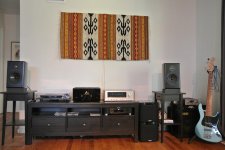
I have gotten some better subwoofers, though. After many different fiddlings, I have the subwoofers in parallel mono with different frequency and sensitivity settings.
The subwoofer on the floor has a very different room response than the one on top of it. But that is a whole different topic.

Attachments
So how do they sound?
I compared them with some Focal 806S’s that have been my main speakers for the past several years. The Focals are no slouch for this type of vented 6+1 speaker. They are from the previous generation and have titanium tweeters and the W-cone sandwich woofers that are now found only in higher-level models. They are relatively efficient, also, rated at 90dB. The tweeter is a little bright, and the bass has a mid-bass hump, but the overall sound is quite transparent and clear. As I recall, Sam Tellig at Stereophile liked the speaker and enthused about the imaging.
I was hoping that the Etons would have a smoother sound than the Focals, especially in the treble, plus another half-octave or so of bass, without losing any dynamic punch. That they do, a very nice sound, just what I was looking for. The efficiency seems to be very similar, also, judging by using one Focal and one Eton in each channel for a while.
What I wasn’t expecting was quite a bit more detail in the treble and upper midrange, but it’s there, right from the get-go with no break-in. Clearly the Eton drivers are up to snuff. One of the promotional phrases for the Eton sandwich tweeters is “all the detail without any sharpness”, which seems like a good description of what I am hearing. What I think I am also hearing is the difference in crossovers. The Focal crossover is visible through a window in the back of the cabinet, and the components look fine but nothing special, with decent coils and no electrolytic capacitors in sight. The Eton crossover, though, has only one Mundorf silver-oil capacitor in series with the tweeter and one Goertz 14 gauge ribbon coil in series with the woofer. This certainly can’t hurt in relation to the very clear sound I am hearing.
In sum: I am very happy with the sound, and I had fun putting this kit together. I think things can only get better as they break in.
I know this is an old posting, but I just replaced the Focal caps with Mundorf's (cheap MKPs) and noticed much the same as you are describing. If you still have the Focal's, I'd recommend them as upgrades, especially since they are relatively inexpensive ($6-$7 per cap)
I happened to build these last fall, also using cabinets from Parts Express - although I went for more traditional cabinets over the curved ones. My experience with these is similar, and yes, they are placed on top of shelves, close to the wall, as they are in my study which is not a big room. I'm now driving them with a pair of Nelson Pass designed ACAs I built, and it is an amazing combination.
I have also put them in my main system, where they resided on Target (not the dept store, the now defunct speaker stand company) stands, about 2 feet from the wall. That system also has a subwoofer in it. I was driving them with to modified Heathkit W-5M amps, and they were fricking amazing. I'm sad to see that it looks like you can no longer order this kit from Madisound.
I have also put them in my main system, where they resided on Target (not the dept store, the now defunct speaker stand company) stands, about 2 feet from the wall. That system also has a subwoofer in it. I was driving them with to modified Heathkit W-5M amps, and they were fricking amazing. I'm sad to see that it looks like you can no longer order this kit from Madisound.
- Status
- Not open for further replies.
- Home
- Loudspeakers
- Multi-Way
- Eton S7 Kit Review
